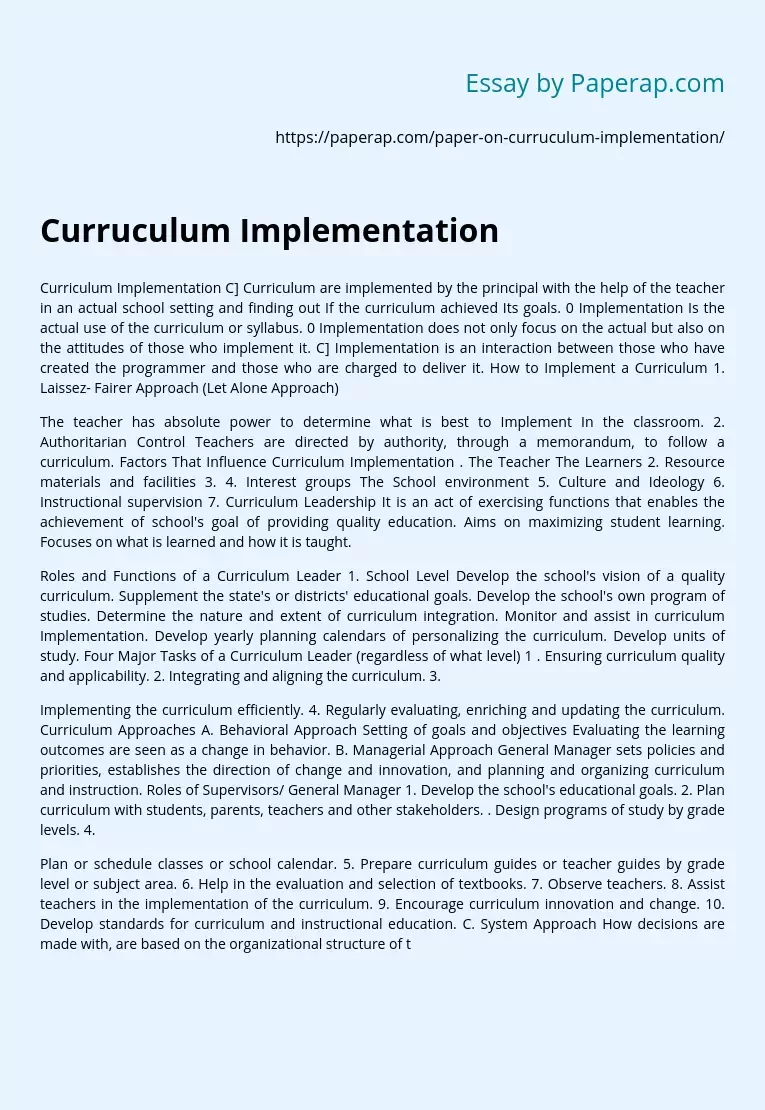Curruculum Implementation
Curriculum Implementation C] Curriculum are implemented by the principal with the help of the teacher in an actual school setting and finding out If the curriculum achieved Its goals. 0 Implementation Is the actual use of the curriculum or syllabus. 0 Implementation does not only focus on the actual but also on the attitudes of those who implement it. C] Implementation is an interaction between those who have created the programmer and those who are charged to deliver it. How to Implement a Curriculum 1.
Laissez- Fairer Approach (Let Alone Approach)
The teacher has absolute power to determine what is best to Implement In the classroom. 2. Authoritarian Control Teachers are directed by authority, through a memorandum, to follow a curriculum. Factors That Influence Curriculum Implementation . The Teacher The Learners 2. Resource materials and facilities 3. 4. Interest groups The School environment 5. Culture and Ideology 6. Instructional supervision 7. Curriculum Leadership It is an act of exercising functions that enables the achievement of school’s goal of providing quality education.
Aims on maximizing student learning. Focuses on what is learned and how it is taught.
Roles and Functions of a Curriculum Leader 1. School Level Develop the school’s vision of a quality curriculum. Supplement the state’s or districts’ educational goals. Develop the school’s own program of studies. Determine the nature and extent of curriculum integration. Monitor and assist in curriculum Implementation. Develop yearly planning calendars of personalizing the curriculum. Develop units of study. Four Major Tasks of a Curriculum Leader (regardless of what level) 1 . Ensuring curriculum quality and applicability.
2. Integrating and aligning the curriculum. 3.
Implementing the curriculum efficiently. 4. Regularly evaluating, enriching and updating the curriculum. Curriculum Approaches A. Behavioral Approach Setting of goals and objectives Evaluating the learning outcomes are seen as a change in behavior. B. Managerial Approach General Manager sets policies and priorities, establishes the direction of change and innovation, and planning and organizing curriculum and instruction. Roles of Supervisors/ General Manager 1. Develop the school’s educational goals. 2. Plan curriculum with students, parents, teachers and other stakeholders. . Design programs of study by grade levels. 4.
Plan or schedule classes or school calendar. 5. Prepare curriculum guides or teacher guides by grade level or subject area. 6. Help in the evaluation and selection of textbooks. 7. Observe teachers. 8. Assist teachers in the implementation of the curriculum. 9. Encourage curriculum innovation and change. 10. Develop standards for curriculum and instructional education. C. System Approach How decisions are made with, are based on the organizational structure of the school district or school. D. Humanistic Approach Learner centered approach. Concentrate in the total development of the individual. Components of the Curriculum A.
Curriculum Aims, Goals and Objectives 1. Aim- Elementary, Secondary and Tertiary 2. Goals- School’s Mission and Vision 3. Objectives- Educational Objectives These are information learned in school 1. Subject-centered View of Curriculum Knowledge accumulated through time due to man’s exploration of his world. Groomer Burner: “Knowledge is a model we construct to give meaning and structure to regularities in experience” 2. Learner-centered View of Curriculum Knowledge to the individual’s personal and social world and how he/she defines reality. Criteria Used in Selection of Subject Matter for the Curriculum 1.
Self Sufficiency Less teaching effort and educational resources. Less learner’s effort but more results and effective learning outcomes in the most economical manner. 2. Significance Contribute to basic ideas to achieve overall aim of curriculum and develop learning skills. Importance of the subject. 3. Validity If the subject is meaningful to the learner based on maturity, prior experience, educational and social value. 4. Utility Usefulness of the content either for the present or future. 5. Learnable Subject should be within the range of the experience of the learners. 6.
Feasibility If the subject can be learned within the tile allowance, resources available, expertise of the teacher, and nature of the learner. C. Curriculum Experience The core and heart of the curriculum. Instructional strategies and methods. Some Guide for Selection and Use of Methods 1. Teaching methods are means to achieve the end. 2. There is no single best teaching method. 3. Teaching methods should stimulate the learner’s desire to develop the cognitive, effective, psychometric, social and spiritual domain of the individual. 4. Learning styles of the students should be considered. 5.
Every method should lead to the development of the learning outcome in 3 domains. 6. Flexibility should be considered in every teaching method. D. Curriculum Evaluation Formal determination of the quality effectiveness or value of the program, process and product of the curriculum. CHIP Model (context, input, process, product) Steps in Curriculum Evaluation 1. Focus on one particular component of the curriculum. 2. Collect or gather the information. 3. Organize the information. 5. Report the information. 6. Recycle the information for continuous feedback, modifications and adjustments to be more.
Major Foundations of Curriculum A. Philosophical Foundation The framework for planning, implementing and evaluating curriculum in schools. Foundation of any curriculum. Four Educational Philosophies 1. Perennials Focuses on reasoning skills and moral thinking. Considers curriculum as constant. 2. Essentialist Focuses in the development of what is essential in the life of man . Centers on the development of basic skills. 3. Progressivism Focuses on the student’s interest, human problems and affairs. 4. Reconstructions Focus on the present and future trends and issues of national and international interests.
Curruculum Implementation. (2017, Nov 19). Retrieved from https://paperap.com/paper-on-curruculum-implementation/

